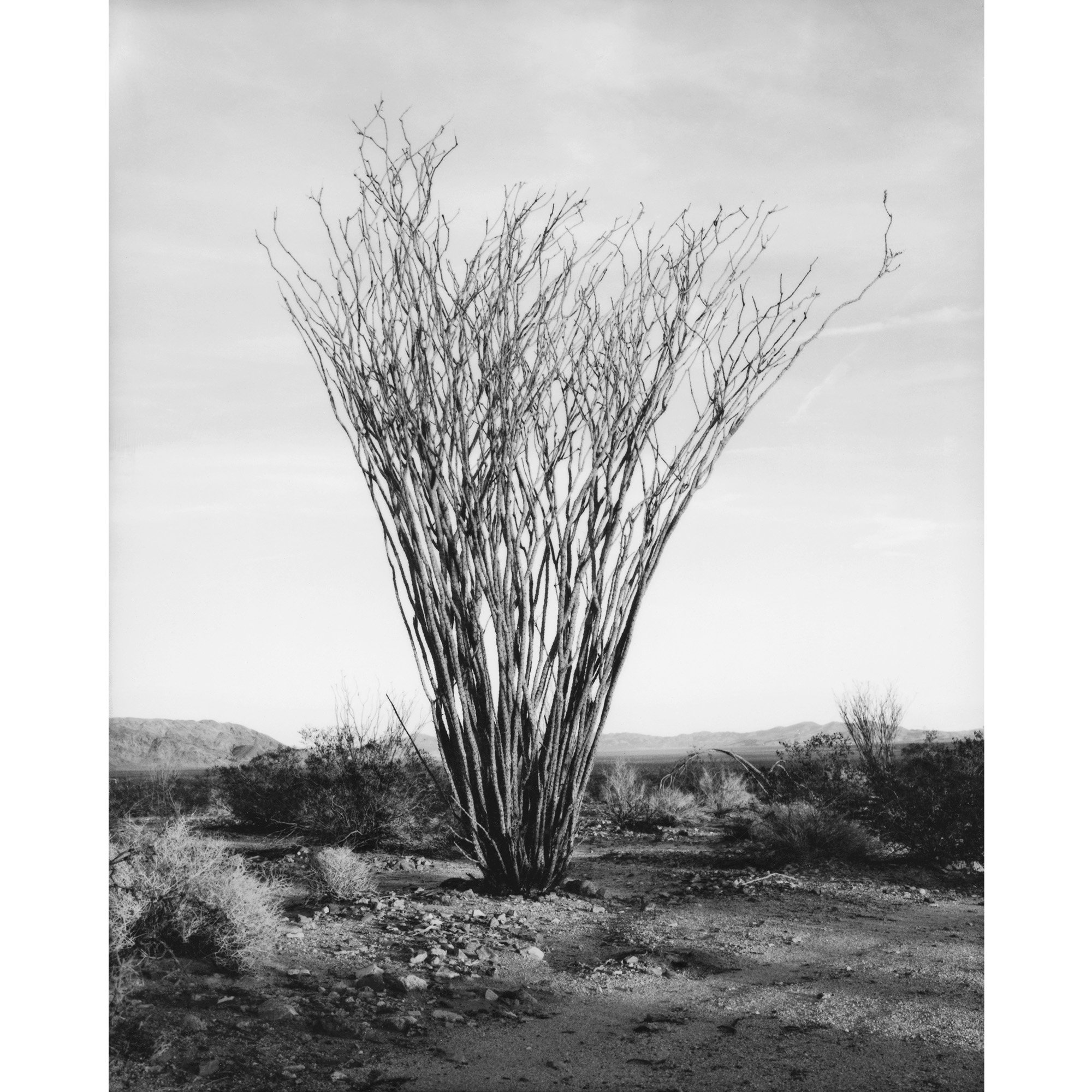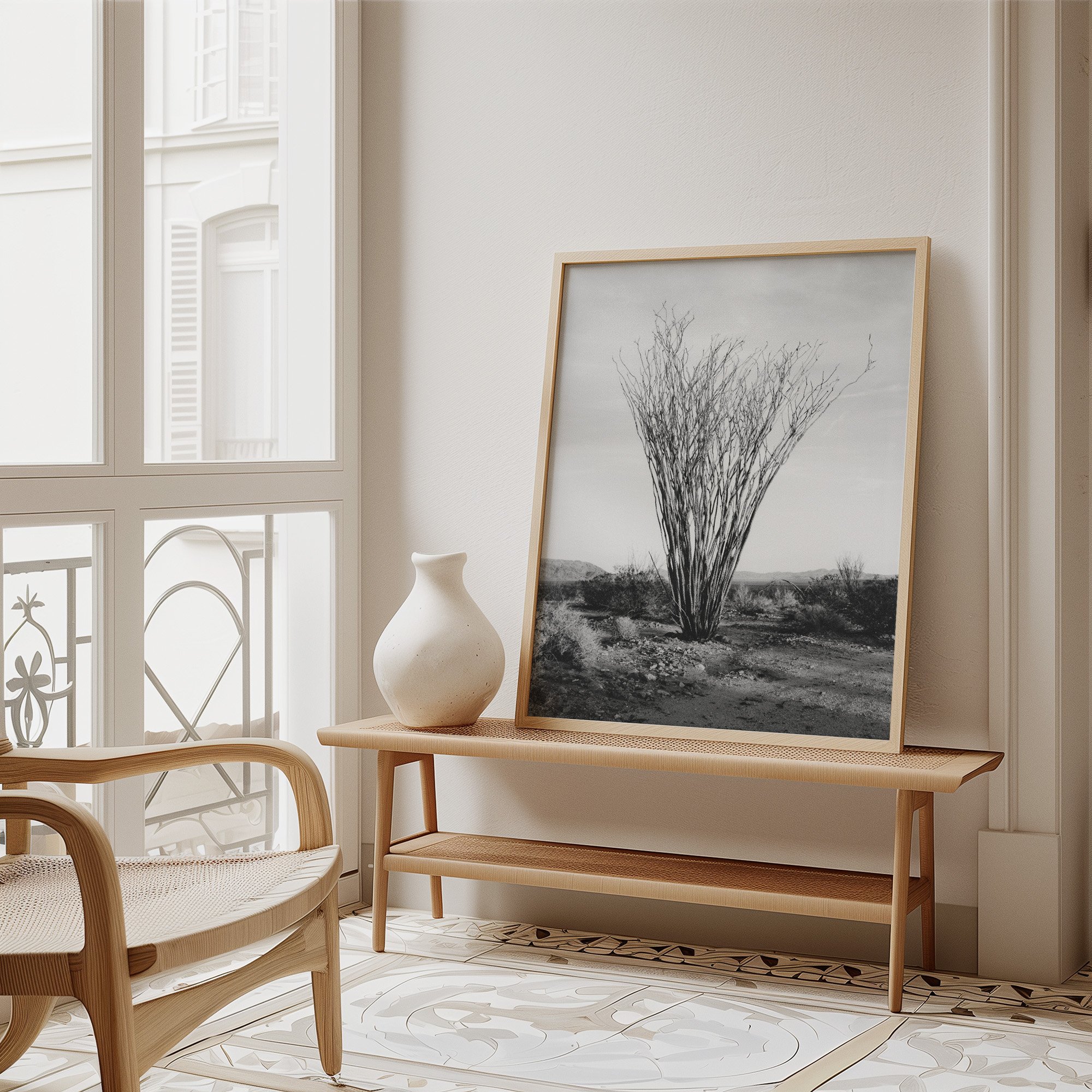Ocotillo
Fouquieria splendens - Ocotillo occurs in desert regions of southwestern United States through central Mexico. It grows in dry, generally rocky soils.
While semi-succulent and a desert plant, Ocotillo is more closely related to the tea plant and blueberries than to cactuses. For much of the year, the plant appears to be an arrangement of large spiny dead sticks, although closer examination reveals that the stems are partly green. With rainfall, the plant quickly becomes lush with small (2–4 cm), ovate leaves, which may remain for weeks or even months.
Native Americans place the flowers and roots of ocotillo over fresh wounds to slow bleeding.
The bright crimson flowers appear especially after rainfall in spring, summer, and occasionally fall. Flowers are clusteredindeterminately at the tips of each mature stem. Individual flowers are mildly zygomorphic and are pollinated by hummingbirds and native carpenter bees.
While living in Southern California I often made visits to the Mojave desert. Joshua Tree National holds a certain magnetism for me with its desert flora and fauna rocks and desert light. In 2016 I bought a derelict homesteader cabin and slowly restored the structure into a livable space. Ocotillo Patch is one of my favorite stops when visiting the National Park.
I made a large format bw study of six different Ocotillo plants in the footsteps of the New Topographics movement. I tried to create a tension with the plants structure against the desert sky in the early morning while considering a more conceptual approach to my American landscape photography.
Series: Ocotillo
Location: Ocotillo Patch, Joshua Tree National Park, CA
Date: 2010
Paper : Canson® Infinity Platine Fibre Rag, Satin, Giclée, 100% cotton, Acid-free, archival, 310 gsm
Edition: 25 signed and numbered
Technical:
Camera: Linhof Technika 4x5 large format
Lens: Nikkor 150mm
Film: Ilford HP5+ bw negative
Fouquieria splendens - Ocotillo occurs in desert regions of southwestern United States through central Mexico. It grows in dry, generally rocky soils.
While semi-succulent and a desert plant, Ocotillo is more closely related to the tea plant and blueberries than to cactuses. For much of the year, the plant appears to be an arrangement of large spiny dead sticks, although closer examination reveals that the stems are partly green. With rainfall, the plant quickly becomes lush with small (2–4 cm), ovate leaves, which may remain for weeks or even months.
Native Americans place the flowers and roots of ocotillo over fresh wounds to slow bleeding.
The bright crimson flowers appear especially after rainfall in spring, summer, and occasionally fall. Flowers are clusteredindeterminately at the tips of each mature stem. Individual flowers are mildly zygomorphic and are pollinated by hummingbirds and native carpenter bees.
While living in Southern California I often made visits to the Mojave desert. Joshua Tree National holds a certain magnetism for me with its desert flora and fauna rocks and desert light. In 2016 I bought a derelict homesteader cabin and slowly restored the structure into a livable space. Ocotillo Patch is one of my favorite stops when visiting the National Park.
I made a large format bw study of six different Ocotillo plants in the footsteps of the New Topographics movement. I tried to create a tension with the plants structure against the desert sky in the early morning while considering a more conceptual approach to my American landscape photography.
Series: Ocotillo
Location: Ocotillo Patch, Joshua Tree National Park, CA
Date: 2010
Paper : Canson® Infinity Platine Fibre Rag, Satin, Giclée, 100% cotton, Acid-free, archival, 310 gsm
Edition: 25 signed and numbered
Technical:
Camera: Linhof Technika 4x5 large format
Lens: Nikkor 150mm
Film: Ilford HP5+ bw negative
Fouquieria splendens - Ocotillo occurs in desert regions of southwestern United States through central Mexico. It grows in dry, generally rocky soils.
While semi-succulent and a desert plant, Ocotillo is more closely related to the tea plant and blueberries than to cactuses. For much of the year, the plant appears to be an arrangement of large spiny dead sticks, although closer examination reveals that the stems are partly green. With rainfall, the plant quickly becomes lush with small (2–4 cm), ovate leaves, which may remain for weeks or even months.
Native Americans place the flowers and roots of ocotillo over fresh wounds to slow bleeding.
The bright crimson flowers appear especially after rainfall in spring, summer, and occasionally fall. Flowers are clusteredindeterminately at the tips of each mature stem. Individual flowers are mildly zygomorphic and are pollinated by hummingbirds and native carpenter bees.
While living in Southern California I often made visits to the Mojave desert. Joshua Tree National holds a certain magnetism for me with its desert flora and fauna rocks and desert light. In 2016 I bought a derelict homesteader cabin and slowly restored the structure into a livable space. Ocotillo Patch is one of my favorite stops when visiting the National Park.
I made a large format bw study of six different Ocotillo plants in the footsteps of the New Topographics movement. I tried to create a tension with the plants structure against the desert sky in the early morning while considering a more conceptual approach to my American landscape photography.
Series: Ocotillo
Location: Ocotillo Patch, Joshua Tree National Park, CA
Date: 2010
Paper : Canson® Infinity Platine Fibre Rag, Satin, Giclée, 100% cotton, Acid-free, archival, 310 gsm
Edition: 25 signed and numbered
Technical:
Camera: Linhof Technika 4x5 large format
Lens: Nikkor 150mm
Film: Ilford HP5+ bw negative



